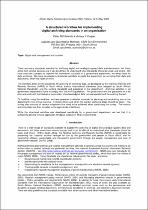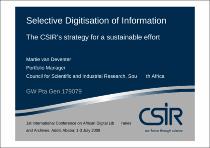 ResearchSpace
ResearchSpace
Structured workflow for implementing digital archiving standards in an organisation
JavaScript is disabled for your browser. Some features of this site may not work without it.
- ResearchSpace
- →
- Research Publications/Outputs
- →
- Conference Publications
- →
- View Item
| dc.contributor.author |
Schmitz, P

|
|
| dc.contributor.author |
Cooper, Antony K

|
|
| dc.date.accessioned | 2009-07-23T10:06:04Z | |
| dc.date.available | 2009-07-23T10:06:04Z | |
| dc.date.issued | 2009-05 | |
| dc.identifier.citation | Schmitz, PMU and Cooper, AK. 2009. Structured workflow for implementing digital archiving standards in an organisation. African Digital Scholarship & Curation Conference, CSIR Conference Centre, Pretoria, South Africa, 12-14 May, 2009. pp 11 | en |
| dc.identifier.isbn | 978-1-86854-741-8 | |
| dc.identifier.uri | http://hdl.handle.net/10204/3507 | |
| dc.description | African Digital Scholarship & Curation Conference, CSIR Conference Centre, Pretoria, South Africa, 12-14 May, 2009 | en |
| dc.description.abstract | There are many standards available for archiving digital and analogue (paper) data and documents, but these come from various sources and it can be difficult to understand what standards should be used, and where. Researchers have executed a project to improve the information standards in a government department, including those for data archiving. Researchers have developed a structured workflow to guide the department on archiving their data and documents, which was report on here. The workflow draws on the guidelines for archiving of electronic data, as developed by the National Archives and Records Services (NARS) of South Africa; various international standards (also adopted as South African National Standards); and the existing standards and guidelines in the department. Archiving activities in all government departments have to comply with the NARS guidelines. The guide starts with the generation of a file plan and ends with the backup or destruction of archived digital data (as appropriate) and the auditing thereof. To facilitate using the workflow, researchers have prepared a detailed example for planning and conducting one of the department’s key annual surveys. It shows where and when the various archiving steps should be taken. The survey plan consists of various milestones that need to be achieved when conducting the survey. The various archiving steps are then included in the appropriate milestones. While the structured workflow was developed specifically for a government department, researchers feel that it is sufficiently general to have application for digital curation in other environments | en |
| dc.language.iso | en | en |
| dc.subject | Data archiving | en |
| dc.subject | Data curation | en |
| dc.subject | Digital curation | en |
| dc.subject | Archiving standards | en |
| dc.subject | Digital data management | en |
| dc.subject | Records management workflow | en |
| dc.subject | National Archives | en |
| dc.subject | Records Service | en |
| dc.subject | African Digital Scholarship | en |
| dc.subject | Archiving process | en |
| dc.subject | Workflow structure | en |
| dc.subject | Curation | en |
| dc.subject | NARS | en |
| dc.title | Structured workflow for implementing digital archiving standards in an organisation | en |
| dc.type | Conference Presentation | en |
| dc.identifier.apacitation | Schmitz, P., & Cooper, A. K. (2009). Structured workflow for implementing digital archiving standards in an organisation. http://hdl.handle.net/10204/3507 | en_ZA |
| dc.identifier.chicagocitation | Schmitz, P, and Antony K Cooper. "Structured workflow for implementing digital archiving standards in an organisation." (2009): http://hdl.handle.net/10204/3507 | en_ZA |
| dc.identifier.vancouvercitation | Schmitz P, Cooper AK, Structured workflow for implementing digital archiving standards in an organisation; 2009. http://hdl.handle.net/10204/3507 . | en_ZA |
| dc.identifier.ris | TY - Conference Presentation AU - Schmitz, P AU - Cooper, Antony K AB - There are many standards available for archiving digital and analogue (paper) data and documents, but these come from various sources and it can be difficult to understand what standards should be used, and where. Researchers have executed a project to improve the information standards in a government department, including those for data archiving. Researchers have developed a structured workflow to guide the department on archiving their data and documents, which was report on here. The workflow draws on the guidelines for archiving of electronic data, as developed by the National Archives and Records Services (NARS) of South Africa; various international standards (also adopted as South African National Standards); and the existing standards and guidelines in the department. Archiving activities in all government departments have to comply with the NARS guidelines. The guide starts with the generation of a file plan and ends with the backup or destruction of archived digital data (as appropriate) and the auditing thereof. To facilitate using the workflow, researchers have prepared a detailed example for planning and conducting one of the department’s key annual surveys. It shows where and when the various archiving steps should be taken. The survey plan consists of various milestones that need to be achieved when conducting the survey. The various archiving steps are then included in the appropriate milestones. While the structured workflow was developed specifically for a government department, researchers feel that it is sufficiently general to have application for digital curation in other environments DA - 2009-05 DB - ResearchSpace DP - CSIR KW - Data archiving KW - Data curation KW - Digital curation KW - Archiving standards KW - Digital data management KW - Records management workflow KW - National Archives KW - Records Service KW - African Digital Scholarship KW - Archiving process KW - Workflow structure KW - Curation KW - NARS LK - https://researchspace.csir.co.za PY - 2009 SM - 978-1-86854-741-8 T1 - Structured workflow for implementing digital archiving standards in an organisation TI - Structured workflow for implementing digital archiving standards in an organisation UR - http://hdl.handle.net/10204/3507 ER - | en_ZA |








